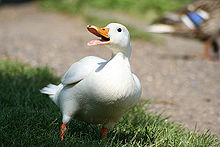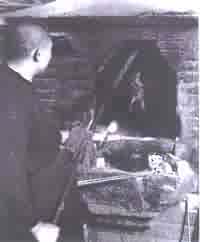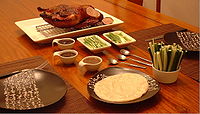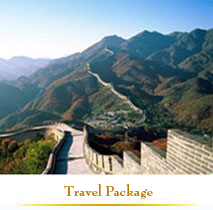
Duck has been roasted in China since the Southern and Northern Dynasties.[1] A variation of roast duck was prepared for the Emperor of China in the Yuan Dynasty. The dish, originally named "Shaoyazi" (????×?), was mentioned in the Complete Recipes for Dishes and Beverages (????????) manual in 1330 by Hu Sihui (??????), an inspector of the imperial kitchen.[2][3] The Peking Roast Duck that came to be associated with the term was fully developed during the later Ming Dynasty,[1][4][5] and by then, Peking Duck was one of the main dishes on imperial court menus.[6] The first restaurant specialising in Peking Duck, Bianyifang, was established in the Xianyukou, Qianmen area of Beijing in 1416.[7]
By the Qianlong Period (1736-1796) of the Qing Dynasty, the popularity of Peking Duck spread to the upper classes, inspiring poetry from poets and scholars who enjoyed the dish. For instance, one of the verses of Duan Zhu Zhi Ci, a collection of Beijing poems was, "Fill your plates with roast duck and suckling pig".[8] In 1864, the Quanjude (??????) restaurant was established in Beijing. Yang Quanren (??????), the founder of Quanjude, developed the hung oven to roast ducks. With its innovations and efficient management, the restaurant became well known in China, introducing the Peking Duck to the rest of the world.[9]
By the mid-20th century, Peking Duck had become a national symbol of China, favored by tourists and diplomats alike. For example, Henry Kissinger, the Secretary of State of the United States, met Premier Zhou Enlai in the Great Hall of the People on July 10, during his first visit to China. After a round of inconclusive talks in the morning, the delegation was served Peking Duck for lunch, which became Kissinger's favorite. The Americans and Chinese issued a joint statement the following day, inviting President Richard Nixon to visit China in 1972. Peking Duck was hence considered one of the factors behind the rapprochement of the United States to China in the 1970s. Following Zhou's death in 1976, Kissinger paid another visit to Beijing to savor Peking Duck.[10][11] Peking Duck, at the Quanjude in particular, has also been a favorite dish for various political leaders ranging from Cuban revolutionary Fidel Castro to former German chancellor Helmut Kohl.[12][13]
Preparation
Raising the duck
The ducks used to prepare Peking Duck originated in Nanjing. They were small, had black feathers, and lived in the canals around the city linking major waterways . With the relocation of the Chinese capital to Beijing, supply barge traffic increased in the area. Often these barges would spill grain into the canals, providing food for the ducks. As a result, the ducks slowly increased in size and grew white feathers. By the Five Dynasties, the new species of duck had been domesticated by Chinese farmers.[14] Nowadays, Peking Duck is prepared from the Pekin Duck (Anas platyrhynchos domestica).[15] Newborn ducks are raised in a free range environment for the first 45 days of their lives, and force fed 4 times a day for the next 15–20 days, resulting in ducks that weigh 5–7 kg (11-15 Lbs).[16] The force feeding of the ducks led to an alternate name for the dish, Peking Stuffed Duck (simplified Chinese: ±±??????; traditional Chinese: ±±??????; pinyin: b¨§ij¨?ng tián y¨?).[17]
Cooking
Fattened ducks are slaughtered, feathered, eviscerated and rinsed thoroughly with water.[9] Air is pumped under the skin through the neck cavity to separate the skin from the fat.[18] The duck is then soaked in boiling water for a short while before it is hung up to dry.[19] While it is hung, the duck is glazed with a layer of maltose syrup, and the innards are rinsed once more with water. Having been left to stand for 24 hours,[20] the duck is roasted in an oven until it turns shiny brown.[21]
Peking Duck is traditionally roasted in either a closed oven or hung oven. The closed oven is built of brick and fitted with metal griddles (Chinese: ó?×?; pinyin: bì zi). The oven is preheated by burning Gaoliang wood (Chinese: ????; pinyin: shú ji¨?) at the base. The duck is placed in the oven immediately after the fire burns out, allowing the meat to be slowly cooked through the convection of heat within the oven.[9][22]
The hung oven was developed in the imperial kitchens during the Qing Dynasty and adopted by the Quanjude restaurant chain. It is designed to roast up to 20 ducks at the same time with an open fire fuelled by hardwood from peach or pear trees.[9][20] The ducks are hung on hooks above the fire and roasted at a temperature of 270°C (525 °F) for 30–40 minutes. While the ducks are cooking, the chef may use a pole to dangle each duck closer to the fire for 30 second intervals.[20] Almost every part of a duck can be cooked. The Quanjude Restaurant even served their customers the "All Duck Banquet" in which they cooked the bones of ducks with vegetables.
Besides the traditional methods to prepare Peking Duck, recipes have been compiled by chefs around the world to produce the dish at home.[18][19]
Serving
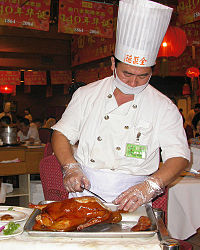
The cooked Peking Duck is traditionally carved in front of the diners and served in three stages. First, the skin is served dipped in sugar and garlic sauce. The meat is then served with steamed pancakes (simplified Chinese: ??±?; traditional Chinese: ????; pinyin: ch¨±n b¨?ng), scallions and sweet bean sauce. Several vegetable dishes are provided to accompany the meat, typically cucumber and carrot sticks. The diners spread sauce, and optionally sugar, over the pancake. The pancake is wrapped around the meat with the vegetables and eaten by hand. The remaining fat, meat and bones may be made into a broth. Otherwise, they are packed up to be taken home by the customers.[23][24][25]
Reheating
Whole Peking Ducks can be ordered as takeaways. The ducks can be reheated at home with an oven, grill or boiling oil. When an oven is used, the duck is heated at a temperature of 150 °C (300 °F) for 20 minutes, and then at 160 °C (325 °F) for another 10 minutes. The grilling method involves filling the duck with boiling water before placing it on a griddle, 70 cm (28 in) above the cooking fire. The boiling water is replaced every 3–4 minutes until the duck's skin is piping hot. To reheat the Peking Duck with oil, the duck is sliced into thin pieces and placed in a strainer held over a wok of boiling oil. The duck is then rinsed several times with the oil.[25]
From:http://en.wikipedia.org/wiki/Beijing_duck
Address: ROOM 103, No 10 Ti Yu Guan Rd, Chongwen District, Beijing
copyright@2010北京百达旅游有限公司
